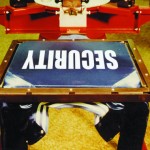 This is a short article about printing on jackets. You know, those tricky little guys that can’t even be used to wipe down a screen if you mess one up. The problem with printing on jackets is one of perception. It looks hard, it seems hard and if you screw up it is real hard on your wallet. That’s the perception. The reality is that if you just follow some simple rules and sound printing practices you can minimize your misprints and be a jacket printing pro. In this short article I want to give you the key points to successfully printing on WATERPROOFED nylon jackets.
This is a short article about printing on jackets. You know, those tricky little guys that can’t even be used to wipe down a screen if you mess one up. The problem with printing on jackets is one of perception. It looks hard, it seems hard and if you screw up it is real hard on your wallet. That’s the perception. The reality is that if you just follow some simple rules and sound printing practices you can minimize your misprints and be a jacket printing pro. In this short article I want to give you the key points to successfully printing on WATERPROOFED nylon jackets.
Rule #1 – Print on a Good Quality Jacket
If possible print on an American made jacket. They are generally made of duPont 6,6 nylon that will take up to 375 degrees F. Many import jackets are made of inferior nylon that will shrink and shrivel under the heat of the dryer. They also have a much heavier treatment of water-repellent that makes it harder for any ink to adhere.
Rule #2 – A Good Holddown is Essential
Without a good holddown you might as well give up. I know that there are other ways to hold down a jacket (get your employees to hold it while sitting on the floor, etc., etc.) but if you are going to expect consistent results then a holddown is just a tool that will make your quality better and reject rate lower. If you don’t want to spend $500 on the holddown for your press, then look at other companies holding devices.
Some manufacturers offer less expensive holddowns that will fit on other brands of presses. You might even make your own if you give a picture of one to your local machine shop or if you are handy with metal and a welder. I strongly recommend having more than one holddown if you are doing more than just a few dozen of the same design. Your production will increase dramatically if you can have one person loading the jacket while someone else is printing on a different station.
An option to a well-made holddown is to use small spring clamps to hold the jacket. These are inexpensive hardware store items that can be a low cost option if you just print a few jackets here and there.
Rule #3 – Use A Proven Ink System
This is just one of my little nit-picks. The industry is notorious for offering products that have not been fully field tested. Just because someone says it is new and better doesn’t mean that it works. If you want to try a new system make sure to do tests! I talked with a printer who had printed over 900 jackets with a brand new ink system. I asked how the ink held up to washing and could see the lights going on in their mind. It never really occurred to them.
The most popular and reliable system is a standard plastisol with a bonding agent added to it. These have been proven over the last ten years to be durable and fairly easy to use. Since plastisol doesn’t “stick” to the tight weave and slippery nylon material you need to “glue” it in place and make the ink more durable at the same time. Bonding agents do just that! They also keep your ink inventory low because they will work with the plastisols you already have on the shelf.
Since plastisols weight will vary depending on the color of the ink, you need to add the bonding agent by WEIGHT when mixing it. Each company has different mixing directions so be sure to ask for the Technical Data Sheet on the product when you use it. If you can’t mix by weight then at least make sure to add more bonding agent to lighter more opaque colors. Once you add the “glue” you have to use the mixture within 8 to 12 hours before it totally hardens. Just mix what you need for a job. If you add too much bonding agent it may actually harden up faster, but if you are in doubt as too how much you need to add – add more.
Rule #4 – Get the Ink the Proper Viscosity
The biggest problem with a plastisol/bonding agent mixture is that the ink becomes much thinner. In fact, it is sometimes too thin to print. If you are printing on a light colored jacket with a lining the ink will penetrate the nylon and actually print the lining. There are a couple of ways to make the ink thicker. You can put the mixture in a refrigerator to make it colder or you can let it sit for a few hours to slowly thicken up. You can also make sure to add the bonding agent to an ink that is already thick in the container. Some brands of ink are thicker than others.
Rule #5 – Use the Correct Screen
All the fuss over ink viscosity is a waste if you don’t use the right mesh. Because the ink is thin, you need to go to a much finer than normal mesh for light jackets. Use a 200 (80cm) to a 250 (96cm) monofilament mesh on light material and drop down to a 125 (50cm) for dark jackets. Think of nylon as being a non-absorbent material. This means the ink won’t really absorb into it like it does when printing on a T-shirt. If printing a process print on an underbase of white use a 355 (140cm) for the process colors and a 175 (68cm) for the underbase. For best results use a metal retensionable frame with fabric tensioned properly. I personally prefer a dual-cure photopolymer emulsion for my stencil since I can hold finer halftone dots than with direct film.
Rule #6 – A Flash Cure Unit is a Must!
A flash cure unit is a must when printing nylon. Not only do you need it to print multi-color, you need it to pre-heat the nylon before the first print. This pre-heating shrinks the nylon for a tighter fit in the holddown, and also softens the nylon and partially burns off sizing, stabilizers and waterproofing. This will help your ink adhere better! To pre-heat the jacket, simply place the flash unit over the jacket while the jacket is in the holddown. If you have the unit set 2″ above the jacket you should be able to pre-shrink and pre-heat the jacket in less than 10 seconds. Running a jacket through the dryer is not the same as pre-heating on the holddown. You defeat the purpose of shrinking the jacket tightly on the holddown.
Rule #7 – Spend Time on Set-up
Take time to set the screen slightly off-contact. This is a must for a clean, sharp print. On some quilted jackets and thick piled lined jackets you may need to print on-contact.
Rule #8 – Printing Technique is Everything
Regardless of what you may think, only certain people are destined to print jackets. It does take a good feel for the squeegee to get a good print. You need to do a stroke that is not too fast or slow. A nice even stroke that cleans off the screen is very important. Use a medium squeegee with a very sharp edge. Too much pressure on the squeegee will allow the ink to press out around the stencil giving a slight ghost to the print. Sometimes a lined jacket will “stick” to the screen when the screen is lifted. As the print “peels” from the screen you get a ring or circular mark in the image.
A nice technique involves doing a good clean stroke and then quickly snapping the screen up. This snap releases the screen quickly from the print and gives a sharper image. It’s all in the wrist. This snap technique may not be necessary if your ink is flowing correctly and the jacket is releasing on it’s own during the stroke. Always try to do just one stroke. If you must do two strokes keep them both in the same direction.
Rule #9 – Auto Flash Units Improve Multi-color
When doing multi-color on nylon you will find that a flash unit that automatically cycles over the jacket will really speed things up. With a jacket, just a few seconds too long and you have crispy nylon. Even though the auto-flash units are over $1,000 they are well worth the investment! Multi-color on nylon is actually quite easy. Simply flash cure between colors. This is where multiple holddowns are a big help. By having more than one holddown you can let a flashed color cool down while you are printing on another station.
Rule #10 – Give them a few days to age
Regardless of how much the customer begs, you need to take care that they don’t wear or wash the jackets for a couple of days. The bonding agent/plastisol mixture needs to age for 48 to 72 hours to be fully hard. You wouldn’t want to pay for a ruined car seat would you?
Rule #11 – Tell the Customer of the Limitations
If you are going to print across seams or on a quilted jacket, let the customer know in advance of the problems you will encounter. It is a little late when he comes to pickup the jackets to say “the quilts were a real problem and the prints look pretty good but not great.”
Rule #12 – Spend Time on Training
Don’t just throw them to the wolves. This type of printing is not for the newcomer… at least without some help. At least give them this article to read or spend time showing them the correct technique. Let them know that you realize there may be misprints!
Summary
If you follow the above rules, you should find printing jackets quite easy. The hard part is throwing away that $20 jacket when you do (and you will) ruin one. Here are two short YouTube videos on this topic.
[viddy f=’yt_TbWkB1-pMNY’ t=’Jacket Printing – Part One’]
[viddy f=’yt_x4WVz7-elhk’ t=’Jacket Printing – Part Two’]













